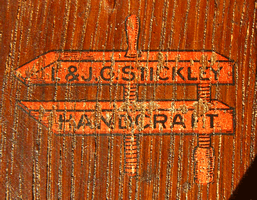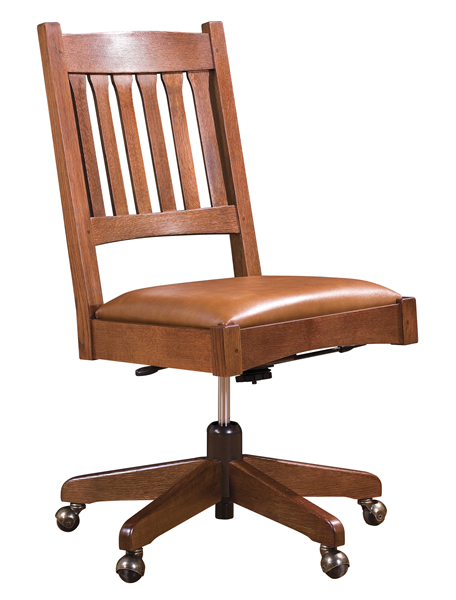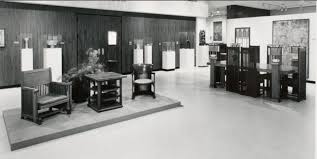by Mary Jane Penzo
The maker of the new Armless Swivel Office Chair #89-3295 that is in Mr. Gamble’s den is L.&J.G. Stickley. The chair is one of the designs the company created when it began offering its Mission line of Arts & Crafts furniture in 1989. All five Stickley brothers—Gustav, Charles, Albert, Leopold, and John George—were in the furniture manufacturing business. They worked independently and together in various combinations and with other partners, and each contributing his unique gifts. Leopold and John George, younger brothers of Gustav Stickley, founded L.&J.G. Stickley in 1902.
Gustav (born Gustave, 1858-7942) was the eldest son of eleven children born to German parents, Barbara and Leopold Stoeckel, in Osceola, Wisconsin. The youngest two sons were Leopold (1869-7957) and John George (1877-7927). To help support the family, Gustav left school at about the age of twelve to work with his father as a stonemason, a job he hated. When his father left the family mother Barbara took her children to Brandt, Pennsylvania, to join her brother, Jacob Schlager. The brothers gained their first furniture experience working in their uncle’s chair factory. Gustav was the most visionary and idealistic of the brothers and is known both for his furniture designs and for his publication, The Craftsman. Leopold was a practical and astute businessman. John George was an accomplished salesman.
For many years, Gustav made ornate Victorian revival furniture, a style he would later repudiate. He became aware of the Arts & Crafts Movement and, in 1898, formed his own Gustav Stickley Company in Eastwood, New York, a suburb of Syracuse. Later, the company name was changed to United Crafts, and still later, to Craftsman Workshops. With the help of designers Henry Wilkinson and LaMont Warner, he produced his trademark Craftsman furniture. Although he lacked formal education, Gustav Stickley was able to gather around him talented and educated people who could carry out his ideas. He was a businessman who wanted to sell furniture; he was also an idealist who wanted to educate people in the basic principles of the Arts & Crafts Movement. Other furniture makers, including his four brothers, followed his leadership in designing Arts & Crafts furniture.
Unlike their brother Gustav, Leopold and John George did not promote Arts & Crafts ideals, but focused on selling furniture. They issued fewer and simpler catalogs than Gustav, but they were attuned to the Arts & Crafts market. During the 1890s Leopold worked as shop foreman with each of his brothers – Charles, Albert, and Gustav. John George was a salesman for all of the brothers. In 1902, Leopold and John George founded the L.&J.G. Stickley Furniture Company in Fayetteville, New York, another suburb of Syracuse. They modeled their company after Gustav’s and competed with him. Most of their work was derivative of his early Craftsman period, but they also created new designs. Their brand name, Onondaga Shops, referenced the county in which the company was located. At first, they advertised their furniture as “plain,” and used chestnut and cedar as well as oak. By 1904, when they first exhibited at Gland Rapids, they referred to their furniture as ‘Arts & Crafts.” Although their early furniture is not as highly regarded as that of Gustav, it was well made of fine quarter’-sawn oak, and well finished.

L.&J.G. Stickley changed its brand name to “Handcraft” in 1906. By 1947, they made a full line of den, library and dining room furniture, and in 1909 added bedroom furniture. About 1907, Leopold hired Peter Hansen (1880-1947), a German-born highly skilled cabinetmaker, carver, and furniture designer, as shop foreman and chief designer. Hansen brought innovation and a new sense of refinement and maturity to the work of L.&J.G. Stickley. He had worked for Gustav since 1904, and his new designs showed the influence not only of Gustav, but also of the Prairie School, the English designers-Voysey, Baillie Scott, Machmurdo, and Gimso—and the Wiener Werkstatte. After Hansen joined the business, L.&J.G. Stickley started producing its most successful furniture.
By 1914, times were changing: Both a shift in popular taste toward the international style and the beginning of World War ended the Arts & Crafts era. Gustav Stickley declared bankruptcy in 1915 after unwise financial decisions, and he ceased publishing The Craftsman in 1916. L.&J.G. Stickley issued a line of reproduction antiques with a Chromewald finish that had been developed by Gustav and in 1917 showed a line of Shaker chairs. In 1916, four brothers, including Gustav, formed the short-lived Stickley Associated Cabinetmakers, which ended in 1918. Although L.&J.G. Stickley issued its last Arts & Crafts catalog in 1922, the J.M. Young Furniture
Company of Camden, New York, continued until the 1940s to make some Gustav and L.&.J.G. Stickley models, mainly chairs, to fill orders from government agencies and private businesses. After 1922, L.&J.G. Stickley concentrated on its Cherry Valley line of Colonial reproductions. John George had died unexpectedly in 1927, leaving Leopold to continue the business until his death in 1957. The family kept the company alive, but by 1974 it had declined to 22 employees working in a small factory. Leopold’s widow Louise sought a buyer in Stickley’s customer and friend, E.J. Audi. E.J. Audi Fine Furniture and Rugs in New York City was the largest retailer of L.&J.G. Stickley furniture. In1974, E.J.’s son, Alfred J. Audi, and his wife, Aminy, bought the ailing company and revitalized it. In 1984, they added an 18th century solid mahogany and solid cherry line. They built a new, modern factory in nearby Manlius, New York, in 1985.
The 1972 exhibition “The Arts & Crafts Movement in America, 1876-1976,” better known as “The Princeton Exhibition,” is widely credited with signaling the start of the Arts & Crafts revival. Dr. Robert Judson Clark, a Princeton University professor, curated the exhibition, which featured approximately 300 examples of furniture, ceramics, glass, leatherwork, metalwork, architectural ornaments, and printed books.
By the mid-1980s, competition for original Arts & Crafts pieces of furniture was intense, and prices had risen sharply Christie’s sale of Gustav Stickley’s own sideboard in 1988 to Barbra Streisand for $363,000 was highly publicized. In 1989, aware of the growing demand for simple, quarter-sawn oak furniture, Alfred J. Audi began reissuing a Mission line of selected pieces from original Gustav and L. &J. G. Stickley blueprints. Mission furniture is made with higher quality construction techniques that were not previously available, a practice that distinguishes it from original pieces. Improvements include side- and center-hung drawers designed in 1930 and book matched panels used on chests and settles. The Mission line includes a full line of furniture and accessory pieces. About 120 reissue models have been produced, accounting for about 30% of the Mission line. New models included office furniture, coffee tables, king-sized beds, and entertainment units.

Reissue furniture is made to look like the original, but construction features and labels identify it as new The Armless Swivel Office Chair #89-3255, now a resident in the den and first made in 2007, contains traditional mortise and tenon construction. The swivel mechanism is a standard one, bought from a supplier.
Furniture is machine and hand sanded. The finishing process differs from that used 100 years ago. Both Gustav and Leopold Stickley favored fuming, a process in which ammonia fumes darken tannins in the wood to produce a rich color and enhance the grain. Today finishing involves the use of a series of clear dyes and stains followed by multiple coats of lacquer to seal in color and ensure a beat- and water- and- alcohol-resistant surface.
Chair labels are placed on the underside of the seat rail. The shop mark containing the name “Stickley” in a scalloped oval is burned into the wood using a hot branding iron. A metal medallion is inscribed with the combined image in red of the Gustav Stickley handscrew with the L.&J.G. Stickley joiner’s compass. It is a variation of the Stickley Associated Cabinetmakers shop mark of 1916-1918, the period during which the brothers worked together. The place name “Manlius, NY, USA” clearly distinguishes reissue Mission furniture from the original.
Alfred J. Audi died in 2007, but L.&J.G. Stickley has continued under the able leadership of Aminy I. Audi and their son Edward J. Audi. In reissuing original Gustav and L.&J.G. Stickley designs and making: new models of furniture in the same style, the company has made Arts & Crafts furniture widely available. It has both benefitted from and significantly contributed to the revival of the Arts & Crafts Movement in America and it has secured the Stickley legacy. It is an honor for L.&J.G. Stickley that The Gamble House has selected a new piece of their office furniture to keep company with its own Greene & Greene furniture.



Leave a Reply